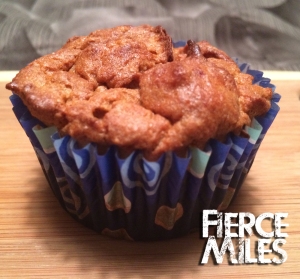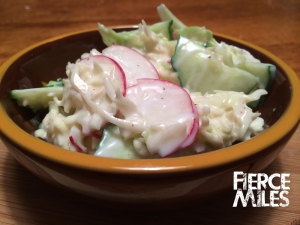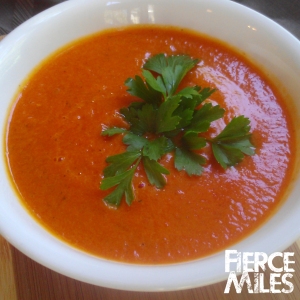Category Archives: food
Fierce Gourmet: A Fit Foodie’s Cookbook
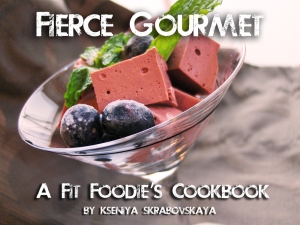 I discovered my passion for cooking right around the same time as I discovered my love for fitness. Nothing makes you feel more alive and in the moment as a new PR and an amazing meal. Quickly realizing that my love for gourmet food and my love for fitness can’t coexist, I had to do something.
I discovered my passion for cooking right around the same time as I discovered my love for fitness. Nothing makes you feel more alive and in the moment as a new PR and an amazing meal. Quickly realizing that my love for gourmet food and my love for fitness can’t coexist, I had to do something.
For years I studied, read, and practiced various preparation methods and techniques, took cooking classes, and searched for places to procure clean, organic meat and produce. As a result of my obsession with flavor and the need to maintain a lean and strong physique, I have developed hundreds of recipes that were beneficial for my health and for my abs, not to mention supported a number of local farmers.
Last year, when I started Fierce Miles, I had a bright idea: why not write an actual cookbook? The majority of the work was already done, all I had to do was test, photograph, write, edit, format, market, and sell the book! Not a big deal, right? Right. After a few months of writing, re-writing, editing, and writing some more, I am just a few short months away from the big day. I am excited and yet a bit nervous.
When I first decided to do this, I had no idea how much work I am going to have to put into this project for it to be what I really want it to become — the absolute go to for every fit food lover. So far, we are right on track. Our Kickstarter page goes live next week, our graphic designer is working on a fabulous book cover that’ll be ready around the same time, and I am almost done organizing the content and the recipes into chapters.
I know, this is an unusual Monday post for me, but I’ve had this on my mind for so long, that it was time to share it with you guys. Stay tuned for more information on Fierce Gourmet: A Fit Foodie’s Cookbook.
3 Easy Steps to Get Fit in 2014
 If you have been anywhere around a TV set, a radio, or a computer, you have noticed the great abundance of “get fit now”. It is that time of the year again. The time when supplement companies and larger than though trainers are pushing their miracle cure all product on the unsuspecting consumers with low self-esteem. Do these products work? Some of them. Do they work safely and for a prolonged period of time? No.
If you have been anywhere around a TV set, a radio, or a computer, you have noticed the great abundance of “get fit now”. It is that time of the year again. The time when supplement companies and larger than though trainers are pushing their miracle cure all product on the unsuspecting consumers with low self-esteem. Do these products work? Some of them. Do they work safely and for a prolonged period of time? No.
We live in a society that is largely driven by instant gratification and impulse. No one wants to work to be fit, but everyone wants to have a fit body of a fitness model. After all, it is much easier to pop a pill and eat a pizza while watching football, than working out and eating clean. Does anyone think about the consequences of taking these drugs? Does anyone stop to ask why they work so quickly and so effectively? No. Why? Because blissful ignorance with a skinny fat body is significantly safer than a challenging and at times difficult reality in which one has to find information, process it, and work to get the results that they want. In short, half-baked approaches breed half-baked results and a lot of disappointed, misinformed consumers. So, what can you do to get lasting weight loss results? Read on.
What I have to say right now may not be what you want to hear, but I am not in the business of cuddling and propagating fitness myths. I am here to give you the hard truth and save you the time you’ll spend doing research on your own. Here’s the deal. Most “magic” weight loss pills, shakes, and powders are unsafe. If you have to order your food premade, you’ll gain all of your weight back after you stop eating “out of the box”. There is no such thing as getting “toned and fit” without changing your daily lives.
The only way to get true and lasting results is by keeping a clean and sustainable diet, maintaining a healthy attitude, and exercising daily.
Keeping a Clean and Sustainable Diet:
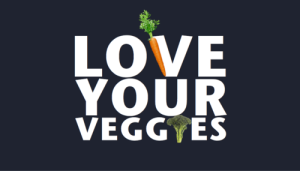 Let’s face it, if you drastically cut calories, completely cut out certain food groups or expect perfect rigid compliance to a dietary plan, you will eventually slip. In fact, when you slip you will binge, feel guilty, get down on yourself, and try to maintain the same diet with even more restrictions than before to make up for your pitfall. Does that sound like a healthy relationship with food? No. To me, that sounds more like an eating disorder and we all know that eating disorders are very unhealthy.
Let’s face it, if you drastically cut calories, completely cut out certain food groups or expect perfect rigid compliance to a dietary plan, you will eventually slip. In fact, when you slip you will binge, feel guilty, get down on yourself, and try to maintain the same diet with even more restrictions than before to make up for your pitfall. Does that sound like a healthy relationship with food? No. To me, that sounds more like an eating disorder and we all know that eating disorders are very unhealthy.
A sustainable diet should revolve around a lifestyle. When you decide to get in shape, you have to realize that you are on a journey and just like any journey, this one will have peaks and valleys. The secret to sustainable, healthy weight loss is realizing that a valley isn’t going to undo everything you worked for. So, if you make it a priority to eat healthy 90% of the time, that one piece of cake on your birthday, a plate full of delicious food on Thanksgiving, and a bowl of macaroni and cheese every other month aren’t going to send you on an express train to fat town.
A clean sustainable diet should involve all of the major food groups (unless you have a medical condition that prevents you from eating certain things) in moderation. Eating for weight loss is an art form that will take time to master fully, there is no diet that perfectly fits all, and there are no shortcuts. A clean, healthy diet with proper caloric intake (you can’t starve yourself!!!) takes time to develop and perfect.
I encourage you to do your research, look at various food plans, study strategic eating, and custom design your own eating plan. It will take time, but in the end you will be rewarded with energy, better health, and a lean, strong body.
Healthy Attitude:
 We briefly touched on this subject in the previous section when we discussed a healthy relationship with food. You can’t punish yourself for slip-ups and deviations of off the plan, but you also have to hold yourself accountable for what you do in daily basis. Having a support group helps, but at the end of the day it is between you and your refrigerator, or between you and your bed.
We briefly touched on this subject in the previous section when we discussed a healthy relationship with food. You can’t punish yourself for slip-ups and deviations of off the plan, but you also have to hold yourself accountable for what you do in daily basis. Having a support group helps, but at the end of the day it is between you and your refrigerator, or between you and your bed.
You have to make a plan and stick to it regardless of what the world around you wants. If you know that what you are doing is right for you, then no one else has the right to keep you away from your goals and your dreams. Not even you. You have to push yourself every day. I wish I could tell you that it gets to a point where going to the gym or out on a run is automatic. No. I still have days when I question why I am up at 5 am on a cold winter morning. There are days when the last thing that I want to do is drive to the gym and lift a bunch of weights when the laundry is piled up, dinner needs to be cooked, and I still have a mound of paperwork to get through. However, I don’t make excuses. I put on my big girl pants, lace up my shoes, and I tell myself that it is better that way. I can say with full confidence, I am yet to regret a workout that I did.
However, healthy attitude goes far beyond building a healthy relationship with food and regular, hard workouts. A healthy attitude also encompasses how you view the world. It is easy to be mad and sad about your circumstances, but when you make a decision to take control and change, you become empowered. Feeling strong and in control is what gets people in the gym initially, but most quickly get discouraged because the results didn’t come fast enough. Here’s the hard part: you have to remain positive and have faith in the fact that the results will come if you actually follow a program that you set for yourself. You have to force yourself to become an optimist on those days when you just want to quit because the pudgy feeling isn’t going away fast enough.
Again, I wish I could tell you that feeling discouraged goes away with time – it doesn’t. But if you keep at it long enough, you will learn that the voice inside your head that tells you “it’s not working”, “you don’t have the body for this”, “you are too old” etc. is a total liar. With time, you learn to ignore your own little critic and you learn that when the voice rears its ugly head, you are closer than you ever were before to achieving that one goal that you set for yourself.
Exercising Daily:
 A good diet and a great attitude aren’t going to get you far without exercise. Consistent, challenging, daily exercise paired with a great diet is a sure recipe for a fabulous body. Now, let me clarify, I am not telling you to go out and do Zumba (although it is a fun way to initially lose some extra weight). The exercise that I am talking about involves 3-4 heavy weight training sessions and 3 cardio sessions a week. You can’t be a cardio queen and expect a toned body of a fitness model. You have to lift HEAVY weights. Let me say this right now: there is no way that you are going to end up looking like a she Hulk unless you are SPECIFICALLY working to attain that aesthetic. So, no, don’t tell me that lifting heavy turns women into men. It is a total myths that is propagated by men who are scared of strong women, women who are scared of hard work, and skinny fat models who would be out of a job if the rest of us woke up and realized that having the ability to pick up more than 5 lbs at a time makes you more attractive and gives you the lean, toned look you actually want. Yes, I’m talking to you ladies.
A good diet and a great attitude aren’t going to get you far without exercise. Consistent, challenging, daily exercise paired with a great diet is a sure recipe for a fabulous body. Now, let me clarify, I am not telling you to go out and do Zumba (although it is a fun way to initially lose some extra weight). The exercise that I am talking about involves 3-4 heavy weight training sessions and 3 cardio sessions a week. You can’t be a cardio queen and expect a toned body of a fitness model. You have to lift HEAVY weights. Let me say this right now: there is no way that you are going to end up looking like a she Hulk unless you are SPECIFICALLY working to attain that aesthetic. So, no, don’t tell me that lifting heavy turns women into men. It is a total myths that is propagated by men who are scared of strong women, women who are scared of hard work, and skinny fat models who would be out of a job if the rest of us woke up and realized that having the ability to pick up more than 5 lbs at a time makes you more attractive and gives you the lean, toned look you actually want. Yes, I’m talking to you ladies.
Gentlemen, I have to caution you against trying to show off. Heavy training means lifting the weight you can ACTUALLY lift with PROPER form. Allow me to elaborate: that means that you shouldn’t be squirming under a barbell during your bench press like a deranged worm because you loaded the bar too heavy. You are not a hero if you get hurt, so why set yourself up for failure? Take it easy, maintain proper tension throughout your exercises and watch your body bulge with awesome rippliness faster than the guy who has been trying to “out lift” you all alone and has been doing it wrong.
 I don’t know about you, but for me, a fit strong body is a status symbol. You can’t buy it, you can pay someone to surgically make it. You have to invest the time, the sweat, the tears and the doubts to achieve it. There are challenges to achieving your perfect physique at any age and in any circumstance, so don’t discount the efforts of the younger crowd just because of their age or the older crowd just because of their experience. We all face different struggles, have different body types, and respond to different things better than others. Building a body you want takes time, it takes trial and error and you have to be willing to invest in your journey fully in order to rip the perfect results.
I don’t know about you, but for me, a fit strong body is a status symbol. You can’t buy it, you can pay someone to surgically make it. You have to invest the time, the sweat, the tears and the doubts to achieve it. There are challenges to achieving your perfect physique at any age and in any circumstance, so don’t discount the efforts of the younger crowd just because of their age or the older crowd just because of their experience. We all face different struggles, have different body types, and respond to different things better than others. Building a body you want takes time, it takes trial and error and you have to be willing to invest in your journey fully in order to rip the perfect results.
Vegetable of the Month: Arugula
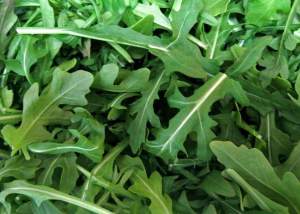 Origins:
Origins:
Arugula or Eruca sativa is an annual, leafy green that belongs to the Brassicaceae family of plants. Despite its lettuce like appearance, Arugula is a close relative of cabbage, kale, mustard greens and cauliflower. This Mediterranean native has a sharp, spicy flavor profile and is a commonly found in Italian, Slovenian, Egyptian, and West Asian, Northern Indian, and Brazilian cuisines.
Medicinal Uses through History:
Arugula appears in Greek and Roman medical lore as an aphrodisiac, diuretic, and a way to restore sight. There have been some records found that indicate arugula was used to treat survey in sailors and administered to those with stomach pains and heartburn in the form of brewed tea. In ancient China arugula and dandelion were considered an effective way of detox and were said to contribute to healthy liver function.
Health Benefits:
Much like the rest of the cruciferous family, arugula is high in vitamin C, A, K, folate and potassium, fiber, phytonutrients, and other antioxidants. Some research suggests that many of the phytonutrients (indoles, thiocyanates, and isothiocyanates, sulforaphane) found in arugula have been linked to cancer prevention.
di-indolyl-methane (DIM) a compound derived from digestion of indole-3- carbinol found in arugula and other cruciferous vegetables has anti-bacterial and anti-viral properties. Some research suggests that DIM may have beneficial effects against Human Papilloma Virus (HPV) of the cervix. However, the study is inconclusive at this time.
Foods rich in Vitamin C help boost immune function, lower cancer risk, improve iron absorption, and help protect cells from free radical damage. Vitamin A found in arugula functions as an antioxidant and an anti-inflammatory agent and promotes retinal, skin, mucous membrane, teeth, and skeletal health. Arugula contains a significant amount of B-complex vitamins (thiamine, niacin, B-6, riboflavin) which are crucial to cell health and proper metabolic function. Another key nutrient found in this leafy green is Vitamin K. 100 g of arugula contains nearly 90% of daily value of Vitamin K which is important for bone health.
Choose Your Arugula:
- Look for crispy bright green leaves
- When picking arugula, avoid collecting from flowered plants as the leaves become bitter
- Store in the refrigerator at relatively high levels of humidity.
Cooking With Arugula:
Arugula is best consumed raw or lightly wilted. Try arugula in a salad, on your turkey burger, or as an addition to your smoothies or juices. In some parts of Italy arugula is used as a pizza topping. It is added right after the pizza is out of the oven to prevent significant wilting.
Sources:
Wood R (1999). The new whole foods encyclopedia: a comprehensive resource for healthy eating. New York: Penguin/Arkana. ISBN 0-14-025032-8.
http://www.fullcircle.com/goodfoodlife/2012/05/21/why-you-should-be-eating-more-arugula/
http://nutritiondata.self.com/facts/vegetables-and-vegetable-products/3025/2
http://en.wikipedia.org/wiki/Brassicaceae
http://www.sciencedaily.com/releases/2009/05/090507101824.htm
http://www.whfoods.com/genpage.php?tname=nutrient&dbid=112
Vegetable of the Month: Cabbage
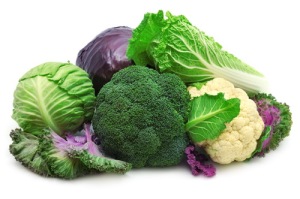 Origins:
Origins:
Cabbage is a leafy green, annual vegetable that is closely related to broccoli, Brussels sprouts, and cauliflower. There are a number of cabbage plant varieties, the most popular of which is the smooth-leafed, firm, green cabbage. There are two other common varieties of cabbage: red and savoy. Red cabbage is a smooth-leafed, firm, deep purple in color with a strong flavor profile. Savoy cabbage on the other hand has a “ruffled” leaf, yellow-green in color, and has a mild flavor profile and softer texture.
Throughout the centuries, cabbage has been used as food and as medicine. Cabbage plants were introduced into European cuisine around 600 B.C. by migratory Celtic tribes and became a dietary staple shortly thereafter. Currently, Russia is leading the charts with the highest consumption of cabbage per capita with Belgium, Netherlands, and Spain coming in as close seconds.
Cabbage as Medicinal Herb:
Because of its high antioxidant and fiber count, cabbage has been used as medicine by many cultures. The Ancient Greeks recommended the use of cabbage leaves as a laxative, cabbage juice to treat poisonings, and help heal bruising. The Romans and Egyptians used cabbage as an anti-hangover cure and a method to prevent drunkenness.
In the early 20th century, cabbage leaves were used to treat ulcers and abscess. Some scientific evidence suggests that certain properties found in cabbage leaves can reduce the pain of engorged breasts (during lactation), and extend the duration of breast feeding by increasing milk production. Other scientifically unsupported uses of cabbage in medicine include the treatment of rheumatism, sore throat, hoarseness, appendicitis, pneumonia, removal of warts and boils, and treatment of mild depression.
Health Benefits:
Cabbage, much like most of cruciferous vegetables, is a great source of beta-carotene (Vitamin A), vitamin C, fiber, and antioxidants. However, unlike most cruciferous vegetables, cabbage boasts impressive levels of polyphenols, an antioxidant in the phytonutrient category.
Phytonutrients are organic components of plants. The term itself derives from the word phyto meaning plant. Although these organic components are not necessary for a person to survive, scientists believe that consumption of phytonutrients can prevent certain cancers and help with minimizing the effects of our toxic environment. Phytonutrients serve as very powerful antioxidants and help enhance immune response, regulate estrogen metabolism, aid in DNA repair caused by exposure to carcinogens, as well as effectively activate a detoxification enzyme (cytochrome P450 and Phase II enzyme system) to remove carcinogenic byproducts of the metabolic process.
Polyphenols are one of the major groups of phytonutrients and are found in a variety of plants such as onion, cranberries, tea, red grapes, grape juice, strawberries, apple, raspberries, blueberries, red wine, cabbage, and nuts. Polyphenols can be divided into two categories: flavonoids and non-flavonoids. Flavonoids are the most extensively studied polyphenols in conjunction with metabolism and cancer prevention.
With that being said, even white cabbage has incredible high amounts of polyphenols (50 milligrams per ½ cup). Red cabbage can arguably be even more effective in terms of delivering a higher concentration of antioxidant and detoxifying nutrients per ½ cup. Red cabbage contains high concentration of flavonoids known as anthocyanins (a very powerful antioxidant that is found in blueberries, Okinawan sweet potatoes, cherries, and other purple colored fruits and vegetables). In addition to having antioxidant qualities, anthocyanins are also an extremely effective anti-inflammatory.
Because of its anti-inflammatory properties, cabbage juice has been used for centuries to treat stomach ulcers. Recent evidence suggests that cabbage can contribute to overall health of intestinal lining and stomach by regulating bacterial population, reducing inflammation, and regulating bowl movement.
Cancer Prevention:
In addition to antioxidants and anti-inflammatory properties, cabbage also contains an impressive concentration of glucosinolates.
Glucosinolates are organic compounds that contain sulfur and nitrogen. Yes, glucosinolates are the reason why your house starts smelling “sulfurey” when you cook your favorite cabbage dishes. Glucosinolates are converted to isothiocyanate compounds which in turn can be very effective in prevention of a number of colorectal cancers.
Different varieties of cabbage contain different amounts of glucosinolates. Savoy cabbage, for instance, contains high concentrations of sinigrin, a glucosinolates that has received a lot of attention in recent years as a cancer prevention chemical.
Although the research on cancer prevention is still on going, adding at least one serving of cabbage to your daily consumption of vegetables can prove to be beneficial for your weight loss and overall health.
Choosing the Perfect Head:
When choosing your cabbage, make sure that the head is firm, bruise free, and has bright, crispy, colorful leaves.
Avoid buying precut cabbage. Once the cabbage is cut it begins to lose some of the essential vitamins and minerals. If you have to store some of the cabbage (that you precut) you should try to use it within a couple of days.
Keep your cabbage cold by placing it in the refrigerator or in a cellar. This will help keep your cabbage fresher longer as well as slow down the breakdown of vitamin C.
Green, Red, and White cabbage will usually keep for up to 2 weeks in the refrigerator, while Savoy cabbage should be consumed within a week, and Bok Choy within a few days.
Cooking Cabbage:
According to some scientists, steaming the cabbage promotes better release of nutrient. Although that might be true, we find that steaming cabbage turns it into an awful mess and produces less than appetizing aromas. We recommend that you sauté, pickle, of consume your cabbage raw. Additionally, you can add your cabbage to soups and stir fries.
Sources:
http://www.ars.usda.gov/aboutus/docs.htm?docid=4142
http://cancerres.aacrjournals.org/content/57/14/3026.short
http://www.sciencedirect.com/science/article/pii/S0308814697001003
http://www.ncbi.nlm.nih.gov/pubmed/10075763
http://www.whfoods.com/genpage.php?tname=foodspice&dbid=19
Kushad MM, Brown AF, Kurilich AC, et al. Variation of glucosinolates in vegetable crops of Brassica oleracea. J Agric Food Chem 1999 Apr;47(4):1541-8. 1999. PMID:13320.
Fierce Thanksgiving Menu
Thanksgiving is less than two weeks away and some of you might be biting your nails trying to figure out how to cut the calories, fats, and sugar out of the traditional meal without sacrificing flavor, color, texture and general appeal of your dishes. Although it is nearly impossible to make every traditional Thanksgiving dish light, here are a few recipes and tips that’ll help you and your family cut the unnecessary decadence without making your dinner bland.
Tips:
I try to cook using as little fat as possible which is why I invested in some incredible nonstick pans. If you don’t have a good nonstick pan, do not worry. The recipes below have measures of olive oil that are labeled “optional”. Those “optional” measures of olive oil are for those who don’t have access to a set of good nonstick pans.
If you are watching your sodium intake, you can cut the salt ratio in half for the dishes that are using lemon juice and lemon zest. Chances are you won’t miss it much. However, I would not alter the turkey brine.
If you absolutely have to use something sweet in one of your recipes, try honey or agave syrup. If your recipes call for candied nuts, try substituting toasted nuts lightly coated in honey instead or omit the honey all together. 🙂
Succulent Turkey Breast:
Thanksgiving wouldn’t be the same without the star of every dinner—the turkey. Here is my fabulously simple recipe for the most delicious and moist turkey you’ll ever eat! I have to put a disclaimer here, give yourself at least 24 hours after the turkey is fully defrosted to properly prepare and treat the bird.
Ingredients: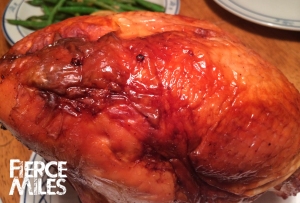
6lb turkey breast
60ml Water
15g of Salt
3 Lemons (juiced)
¼ cup Soy Sauce
1tsp Chili Powder
1 Tangerine Orange
1 Bunch of Lemon Thyme
2 Rosemary Sprigs
Directions:
Wash and clean the turkey breast. Take care not to cut or puncture the skin. Set the bird on a wire rack of a regular roasting pan to drain. In the meantime, combine water, salt, and lemon juice and stir until the salt is completely dissolved. Fill a marinade injector with the brine. Find a few places on the breast that do not have skin and inject the brine. Usually, one 30 ml injector full of brine is enough for a 6 lb. turkey breast. Discard the leftover brine.
Combine soy sauce and chili powder. Mix well. Using a basting brush, brush the soy sauce mixture on your turkey. Set the turkey in the refrigerator, uncovered for 12-24 hours.
After the turkey spent at least 12 hours in the refrigerator, preheat your oven to 325 °F. Stuff the cavity of your turkey with rosemary sprigs, thyme, and a halved tangerine. Cook your turkey uncovered for 2.5 hours or until the meat thermometer reads 170 degrees. You shouldn’t have to baste or treat your bird in any other way. The skin is going to be golden brown and the inside extremely juicy. After the turkey is done, cover the bird with foil and let it rest for 10-20 minutes before serving.
Healthy Stuffing
Ingredients: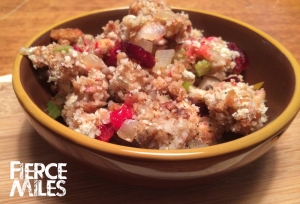
12 slices of Whole Wheat Bread
1 tbsp olive oil + ½ tbsp. for cooking the veggies (optional)
½ tsp of salt
1 tbsp Italian Seasoning
½ tsp Sage
½ Sweet Onion (diced)
3 Celery sticks (diced)
½ cup Fresh Cranberries (whole)
2 cups Baby Bella Mushrooms (diced)
¼ cup Dried Cranberries
2 cups of Chicken Broth
Directions:
Preheat the oven to 325 °F. Cut the bread into ½ inch squares and set aside. In a large bowl combine olive oil, salt, Italian seasoning, sage, and the bread. With your hands, gently toss the bread in the mixture until all cubes are evenly coated. Place the bread on a cookie sheet and bake for 15-20 minutes or until the croutons are crispy. Allow to cool, pulse in a blender or a kitchen processor until the bread is about pea sized.
In a nonstick pan combine diced onion, celery and mushrooms. Cook until the mixture has reduced by about a quarter or until the mushrooms are gold and onions are lightly caramelized. Add the Chicken Broth and bring it to a gentle boil, add in the cranberries, wait until the broth mixture is boiling again and add in the bread. Stir gently to incorporate all of the ingredients, turn of the heat and let the mixture rest for a minute or two before serving.
Green Beans
Ingredients: 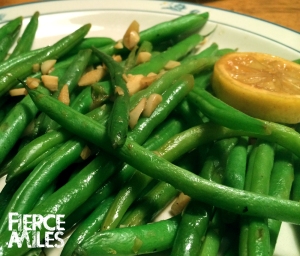
1 lb. of Green Beans (cleaned)
Zest of 1 lemon
2 tbsp lemon juice
2 garlic cloves (minced)
1/4 tsp sea salt (optional)
½ tsp olive oil (optional)
Freshly ground pepper
Directions:
Combine green beans, lemon juice, pepper (optional), salt (optional), and minced garlic. Cook stirring occasionally until green beans are tender. Garnish with lemon zest and serve.
Roasted Acorn Squash
Ingredients: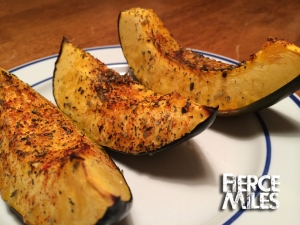
1 Acorn Squash (cleaned and cut into wedges)
1 tbsp olive oil
1tbsp rosemary (minced)
1tbsp Chives (minced)
Zest of ½ Lemon
Sea salt
Directions:
Preheat the oven to 325 °F. Wash, clean, and cut the squash into wedges. In a small bowl combine the oil, rosemary, chives, and lemon zest. Arrange your squash wedges in a baking dish and brush them with the herb mixture, add salt. Bake for 30 minutes or until tender.
Roasted Red Pepper and Acorn Squash Soup
It is most definitely soup weather and nothing warms me up better after a long run than a nice bowl of rich and creamy Roasted Red Pepper and Acorn Squash Soup. It tastes like comfort and packs a serious nutrient punch. It is easy and fairly quick to make especially if you have chicken or veggie broth on hand. I prefer to make my own broth and roast my own peppers, but you can use store bought if you are strapped for time.
1 Acorn Squash
4 Red Bell Peppers
2 Cups Broth
2 tbs Olive Oil
1 tsp Salt
1 tbsp Rotisserie Seasoning (any rotisserie chicken seasoning will do)
1 tbsp Marjoram
1 tbsp Basil
Dash of Cayenne (optional)
Dash of Cumin
Dash Caraway
Directions:
Preheat the oven to 350 degrees, peel and cut Acorn Squash into a few pieces, coat with olive oil, rotisserie seasoning, and salt and bake for 25 minutes or until tender.
In the mean time, roast peppers on the hot grill until the skin blisters and chars. Put the peppers into a large bowl and cover with aluminum foil. Allow to rest for 10-15 minutes.
After the peppers have rested, peel the skin (it should come off pretty easily) and take out the seeds. Cut the peppers into small strips.
In a medium sized pot, combine the remaining spices and 2 cups of broth. Add the squash and the peppers and simmer for 10 minutes to combine the flavors. Allow the soup to cool and blend in a blender until silky smooth or use an immersion blender to do the same.
Garnish with your choice of toppings and enjoy!
Chicken and Spinach Meatballs
Recently, we had a few unusually cold evenings and I began craving comfort food like I do at the end of every warm season. Call it what you will, but I’d like to think that this is more of a cultural thing. I come from a cold country where you have to stock up on fat for the winter or you’ll freeze. Well, not really anymore, but you get the point. So, every year around the end of summer I struggle with my nutritional compliance because the only thing that I want to do is eat pork roast, mac and cheese, meatballs, and bread. Yes, my inner Russian is screaming for potatoes and other carb and fat heavy foods. Do I give in? No! Why? Because a bowl of mac and cheese is not worse throwing out a day at the gym. Not to mention after eating clean for a while, my system goes into shock and has no idea what to do with all the delicious, heavy, goodness I just gave it. So, naturally I stop feeling well and start feeling just slightly heavy, wobbly, and blah. Honestly, it is not a comfortable feeling and I’d rather stick to clean and amazingly delicious food.
One of my favorite winter comfort foods are meatballs. I love a good meatball and I love the versatility of it. You can putt a meatball over almost anything and make it taste amazing! Which is why I developed this wonderful green meatball recipe. It goes well on salads, in wraps, on sandwiches, as a soup garnish, and in the morning eggs… Short of dessert, I put these meatballs in almost every meal in my day and it works well! Well, I am not going to continue telling you how incredible they are and just let you make them for yourself. Here’s the recipe.
Ingredients:
1lb Ground chicken
3 cups Fresh spinach
1 cup Reduced fat Feta Cheese
1/2 tsp Paprika
1tsp Yellow curry
2 Garlic Cloves
1/2 tsp Freshly ground black pepper
1/4 cup Chicken Broth
2 tbsp Olive Oil
Directions:
Combine spinach, feta cheese, paprika, curry, garlic, and black pepper in a kitchen processor. Pulse until the mixture is incorporated but not liquid. In a large bowl combine the spinach mixture with the ground chicken and mix until well incorporated.
Preheat a non stick pan, add olive oil. Using a tea spoon, scoop the meatball mix into the pan and brown on a couple of sides to lock in the moisture. This is a quick process and shouldn’t take more than a 1/2 a minutes on either side depending on the temperature of your pan and the size of your meatball.
Once the meatballs are browned, add the chicken broth, lower the heat, and cover with a lid. Allow to steam for 7-10 minutes depending on the size of your meatball. Remember, larger meatballs will cook slower. If you are not sure if your meatballs are done, pick the largest one and cut into it. If the center looks wet, you probably have a few more minutes to go.
After your meatballs are done, serve them with quinoa, veggies, beans, or atop of a refreshing Spring and Feta Salad (pictured).

